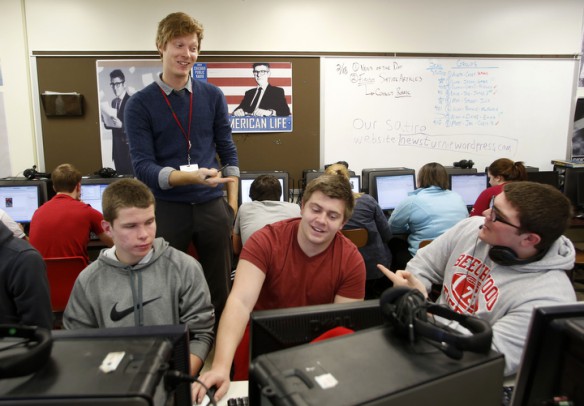
Journalism teacher Mike Piergalski guides seniors Jared Sletto, David Allen and Joe Macejko in writing a satire piece, similar to the style found in The Onion, at Beechwood High School (Beechwood Independent). “My journalism class allows for constant creativity, whether it’s in the form of blogging, podcasting or producing satirical pieces,” Piergalski said. Photo by Amy Wallot, Feb. 19, 2014
By Susan Riddell
A lot of principals will tell you their school is really connected to its community, and that’s a key element in student success.
But for Beechwood (Independent) High School, it’s just a little different.
“We have that here,” Principal Ben Zimmerman said, “but overall, I feel like the community values not only our school but the education the kids are getting, too. It’s really connected to us.”
Zimmerman said that has made for a great partnership and one of several reasons why Beechwood became the first public high school in Kentucky named as a Blue Ribbon School since 2007.
“There’s a lot going well for us right now, said Zimmerman, who noted Beechwood facility and technology upgrades have helped the school make improvements in recent years.
English teachers at the school agreed one of the best pieces of evidence regarding student progress has been ACT scores, and while the highest numbers are in English and language arts, the school’s overall average score is 25.3.
“I think the scores speak for themselves,” said English teacher Julie Rash, who teaches junior English and a senior college and career class.
“It’s high expectations,” Zimmerman added. “From the parents in our community on down the line to the students, everyone here values what a good education means and where it leads.”
The school’s ACT scores are above state averages in every content area, with English and language arts scores topping out at a 27.1.
Additionally, the percent of students meeting the Kentucky Council on Postsecondary Education’s (CPE’s) College Readiness Benchmarks on the ACT (18 on English; 19 on mathematics; and 20 on reading) at the school is close to 97 percent in English; 86.7 in mathematics and 83.3 percent in reading.
Both Rash and Zimmerman agreed that the school’s vertical alignment is a big reason why student test scores are high and the school earned a Blue Ribbon honor this year.
“The teachers have made our alignment just a seamless transition for the students,” Zimmerman said. “They know where kids are when they come to them, and even though our scores are good, it’s really not about that for our staff. It’s about continued learning. When it comes to that, I’d put any kid in any room with one of our teachers. They all are same page with everyone, and I don’t have to worry about anybody.”
Rash said the alignment is a simplistic approach made easy by having a smaller district, and the assurances of knowing what others teachers are doing frees her up to focus on other things.
“We have control, and you can do so many great things when that’s the case,” Rash said. “We can take ownership of what we’re doing and focus on relationships with our kids. It’s our responsibility to get them ready for college and career and meeting their benchmarks. It makes all the difference when I know what the kids have had, and I don’t have to repeat content.
Fellow English and journalism teacher Mike Piergalski said that it helps having administrative support in addition to teacher support across the grade levels.
“In my opinion, what makes Beechwood exceptional is that the administration allows the teachers the autonomy to teach the way they feel the lessons should be taught,” said Piergalski, who teaches sophomore-level courses. “I feel a sense of trust from my superiors … to incorporate best practices into my lessons and do right by the kids. This is immensely satisfying.”
Piergalski said some of those best practices for him include sentence diagramming during grammar instruction and enriching discussions on debatable topics.
“Apart from the gains in the quality of the sophomores’ grammatical abilities, which I attribute to the great work done by (other English teachers at the school), I’ve seen a change in my students’ willingness to delve into the gray area in the middle of many true arguments,” he said. “It’s easy to take one particular side in an argument – it takes more skill to address the area in which the solution probably lies: the middle.”
Teacher collaboration is another reason why students are successful at the school, the teachers said. Zimmerman added that each content team succeeds whether that’s individually or through that collaboration.
“Our English department is strong, but our other departments are strong, too,” he said. “I’m very proud of how well everyone here works together, and we all share our successes.”








Leave A Comment